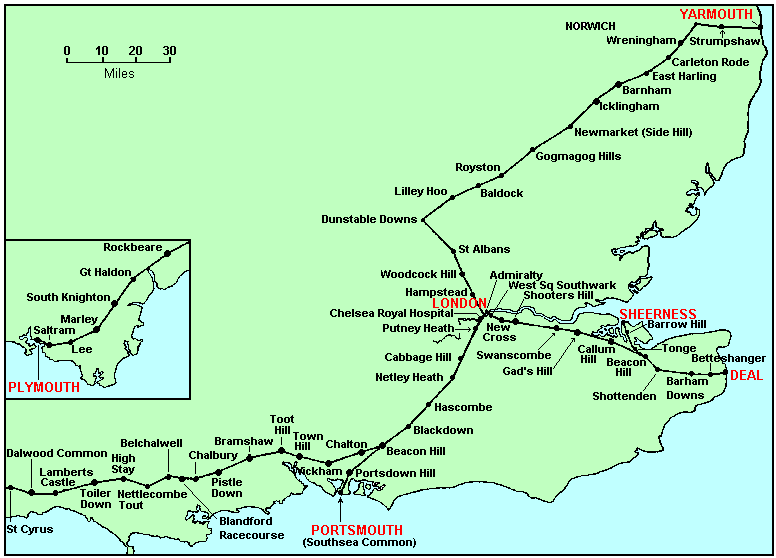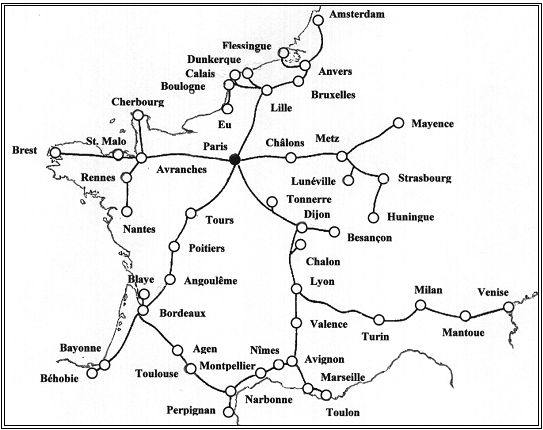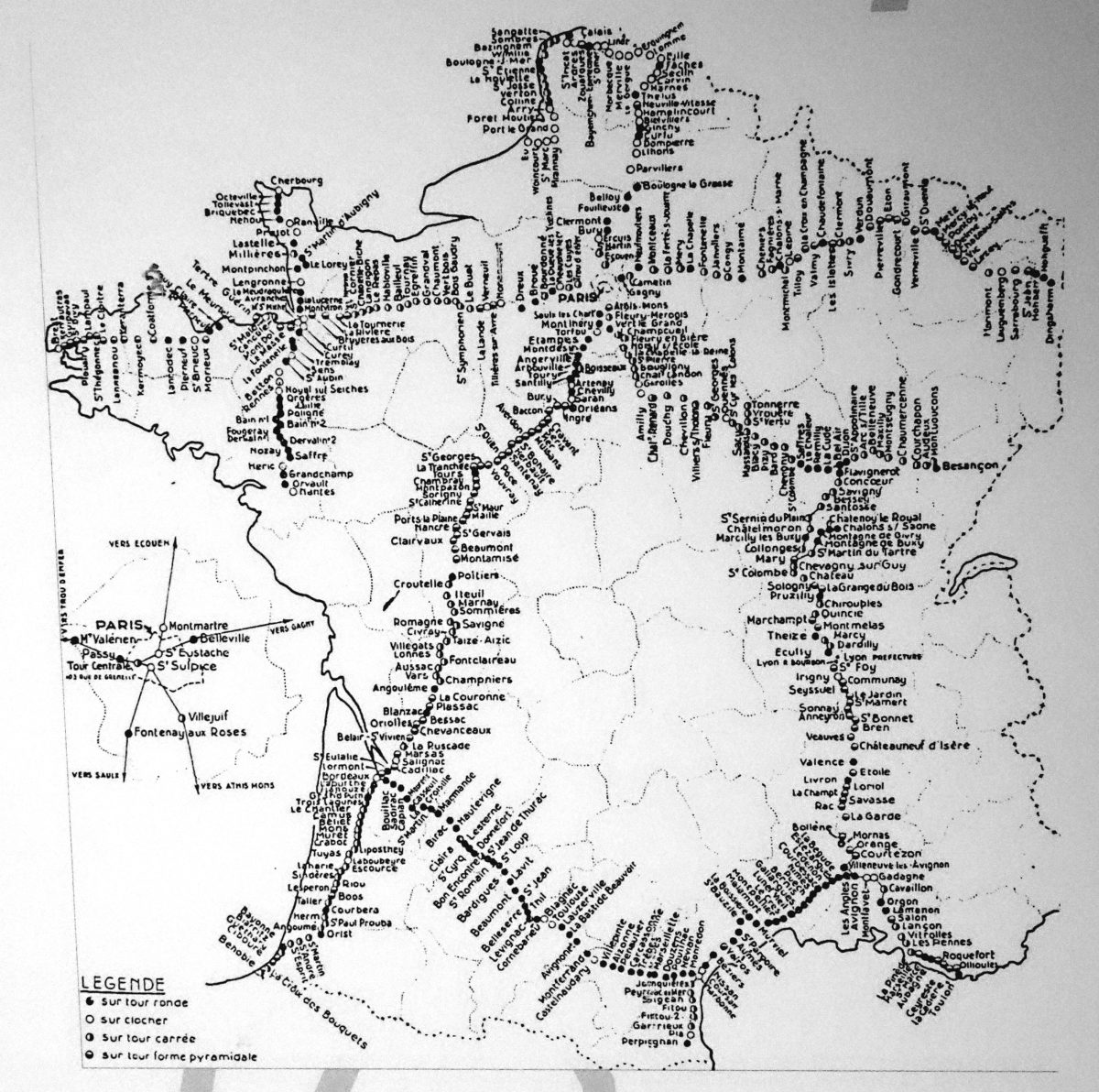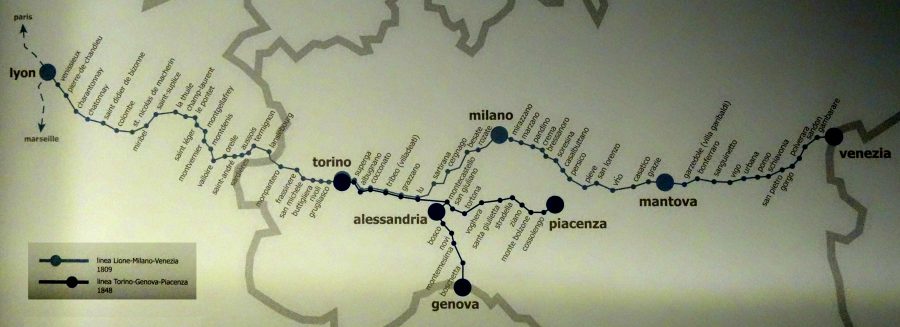The first practical telegraph system was inaugurated in France by Chappe in 1794; this was a semaphore or moving-arm type. The stimulus for this was command and control of the French armed forces in the Revolutionary wars. The idea was quickly adopted in Britain, (which was at war with France for almost all this period) where there were clear advantages in rapid communication with the coastal ports where the British Navy was based. After tests a shutter type was adopted, rather than a semaphore, and by the end of 1796 two telegraph lines were in operation.
A shutter telegraph station had six pivoted boards, which could be swivelled by the ropes leading down to the cabin, so they were either visible or edge-on. Six shutters gives a 6-bit binary code, allowing 63 non-zero states to be transmitted. These were allocated as the 26 letters of the alphabet, ten numerals, and some useful preset sentences, such as "Defeat the French Navy immediately".
The average London-Portsmouth message took about fifteen minutes to get there. Data-compression was used in the form of omitting the vowels in common words. The preparatory signal could be sent from London to Deal or Portsmouth, and be acknowledged in two minutes; an early version of the "ping". It is said that a similar ping from London to Plymouth and back- a total distance of ?00 miles- took only three minutes. This really is rather impressive.
The Deal and Portsmouth Lines were completed in 1796; a trial Portsmouth-Plymouth "ping" took 20 minutes.
In 1816 the Shutter telegraph was replaced by a Chappe or semaphore type, trials having convinced the authorities that this system gave better visibility.
 |
| Left: map of the routes of the Admiralty Shutter Telegraph.
The semaphore system that replaced it took slightly different routes.
|
 |
| Left: a recent (1950-ish) drawing of the interior of a telegraph station.
Two stout fellows haul on the ropes to transmit codes, while the chap to the right receives messages from the next station. This has been drawn as much too close; the actual average distance between stations was about 10 miles. No span exceeded 14 miles.
An optical telegraph such as this is obviously vulnerable to fog and other meteorological difficulties. The builders of the Lines were perfectly well aware of this, and went to considerable lengths to build stations that were as high as possible and clear from local fog conditions. The telegraph was able to work throughout the hours of daylight on at least 200 days per year.
|
Timescale:
Aug 1794
Semaphore telegraph inaugurated in France by Claude Chappe
Aug 1795First trials in England
Sept 1795Surveyor appointed to lay out Lines
Jan 1796London-Deal Line completed
??? 1796London-Portsmouth Line completed
May 1806Plymouth extension completed
June 1808London-Yarmouth Line completed
May 1814Shutter Telegraph dismantled
May 1816Construction of Admiralty Semaphore Telegraph begins
Feb 1845Electric Telegraph installed London-Portsmouth
Dec 1847Admiralty Semaphore Telegraph closes
Mar 1849Admiralty Electric Telegraph completed
| | | | | | | | | | | | | | | | | | | | | | | |
The timescale above shows that the new technology was adopted, and a successful system constructed, with quite impressive speed. Never underestimate your ancestors.

FRANCE: 1794
The first optical telegraph network was set up by the French engineer Claude Chappe and his brothers in 1792-94. Ultimately France had a network of 556 stations stretching a total distance of 4,800 kilometres (3,000 miles). The Chappe system was used extensively by Napoleon in his campaigns, and was still in use for military and national communications until the 1850s, expansion of the system ending in 1853
The French system is well described on the Wikipedia page, and so only brief details are given here.
 |
| Left: Diagram of a Chappe telegraph station
The telegraph consisted of two rotating arms mounted at each end of a middle third rotating arm. The arms were moved by means of a compound crank and ropes. Only two men were required to operate each station, reducing manning costs, but optical telegraphs were always costly because of large amounts of infrastructure and manpower required.
The telegraph stations are shown much closer together than they were in reality.
|
 |
| Left: Simplified map of the Chappe system in France
The first line was built from Paris to Lille.
A very large number of intermediate stations are not shown.
Note the international links to Belgium, Holland, and to Italy via Lyon and Turin. This was before either Belgium or Italy actually existed as integrated countries.
Flessingue is the French version of the Dutch name Vlissingen. In Great Britain we call it Flushing.
|
 |
|
Above: Detailed map of the Chappe system in France
There were a very large number of intermediate stations to be maintained and manned. This remarkable map even shows what shape of tower the telegraph arms were mounted on.
Note the eastern route out of Paris via Belleville; this is referred to on page for the Paris compressed-air network.
Image from the Science Museum in Milan.
|

ITALY
The Chappe system was extended across the states of Piemonte, Lombardy and Venezia under Napoleon in 1809. The second line to Genova and Piacenza was built (presumably under the restored French monarchy) in 1848.
Very little on the Italian system can be found on the Internet.
 |
| Left: Map of the Chappe system in Italy
From the Science Museum in Milan
|

OPTICAL TELEGRAPHS IN FICTION

THE ELECTRIC TELEGRAPH
In 1844 Samuel Morse demonstrated an electric telegraph operating between Baltimore and Washington. The days of the optical telegraph were numbered- but it was a big number. The French only began to replace semaphores with electric telegraphy in 1846, carry on using their optical telegraphs until the 1850s.
The electrical telegraph was faster and much cheaper, requiring operators only at each end, but there were objections: people said of the wires "it could be cut anywhere' which was certainly true, but proved not to be a problem, in peacetime at least.

















